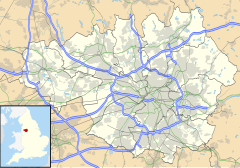Stand, Greater Manchester
| Stand | |
|---|---|
 Stand Unitarian Chapel | |
Location within Greater Manchester | |
| OS grid reference | SD794055 |
| Metropolitan borough | |
| Metropolitan county | |
| Region | |
| Country | England |
| Sovereign state | United Kingdom |
| Post town | MANCHESTER |
| Postcode district | M45 |
| Dialling code | 0161 |
| Police | Greater Manchester |
| Fire | Greater Manchester |
| Ambulance | North West |
| UK Parliament | |
Stand is a residential area in Whitefield, Greater Manchester, England. The name is derived from a hunting stand, from which the surrounding countryside could be scanned for game.[1]
Stand Old Hall, built on the highest point in Whitefield overlooking Pilkington Deer Park (now the junction of Stand Lane and Ringley Road) was the manor house of the Pilkington family, Lords of the Manor of Pilkington and Bury. Stand Old Hall was replaced by Stand Hall around 1515 after the Earl of Derby took control of Pilkington. The old hall was converted into a barn and in the 19th century it became a shippon (cowshed). The old hall fell into disrepair and was demolished in the early 1960s.[2] The view from Stand Hall was described in 1806.[3]
All Saints' Church on Church Lane is a Grade I Listed Anglican parish church designed by Charles Barry and built between 1821 and 1826.[4]
Stand Grammar School was founded in 1688 under the will of Henry Siddall and had close connections with the Unitarian Chapel in Ringley Road. The school ran into financial difficulties in the early 20th century and was taken over by Lancashire Education Committee in 1908. A new school was built on Church Lane on seven acres of land bought from the Earl of Derby and opened on 6 September 1913. The school catered for both boys and girls until 1937 when a separate girls' school was opened on Higher Lane. The boys' school continued to develop with 700 pupils on roll and eventually became part of Bury College and was demolished in 2001.
Some believe Robert Clive had links with the school in his early years.[5] Accounts suggest that the Old Standians’ Association began attempts to link Clive to the school some time around 1907. Sir Colvin Bayley (the grandson of Clive’s uncle) stated at a school event that he had been informed Clive had attended the school, prior to living in Hope Hall in Eccles. However, this link has been queried, as even as Bayley admitted, there is no mention of it in any records.[6] Despite this, the Old Standians' Association erected a bronze plaque and named one of the school's houses in his honour in 1913.[7][8]
Some of the alternative rock band Elbow met whilst studying at Stand College in the 1990s.[9] Stand Grammar School for Girls on Higher lane was later renamed Philips High School and is now a comprehensive school and specialist maths and computing college.[10]
References
[edit]- ^ Higson, John. "WHITEFIELD - near Manchester - England: STAND HALL(s)". John Higson. Retrieved 29 May 2013.
- ^ Anon. "Dig at Stand Old Hall 2009". Prestwich & Whitefield Heritage Society. Prestwich & Whitefield Heritage Society. Retrieved 29 May 2013.
- ^ Farrer, William; Brownbill, J (1905). "British History Online". A History of the County of Lancashire Vol 5. Retrieved 18 January 2014. "The large town of Manchester spreads along the valley in front of the house at some miles distance, and the less one of Bury is seen distinctly to the left, surrounded by villages, with simple cottages dispersed along the plain. The hills of Lancashire, Derbyshire, Cheshire, and Yorkshire rising in succession, spread in a vast amphitheatre, till lost in the immensity of space; while the rugged tops of the Welsh mountains, which I gazed upon as old friends, hide their heads in the clouds, of which they seem to form a part.... The neighbourhood abounds with families of immense wealth, and reminds me of what Clapham Common is to London. The villas of the gentry are handsome, and their pleasure grounds are tastefully laid out. The rich woods and green park of Heaton House, the seat of the Earl of Wilton, appear from the terrace of Stand Hall to much advantage; but the most prominent feature in this landscape is the pretty church of Prestwich."
- ^ Bailey, Dorothy. "All Saints, Stand: About our Parish". The Church of England: A church near you. The Church of England. Retrieved 29 May 2013.
- ^ Wilson, John F. (1979). A History of Whitefield. p. 5. ISBN 0-9506795-1-8.
- ^ Staff Correspondents (1 August 1907). "Stand Grammar School: Where a Clive Commemoration Was Held Yesterday". The Manchester Guardian.
{{cite news}}:|last1=has generic name (help) - ^ "A Clive Memorial at Stand School". The Manchester Guardian. 4 September 1913.
- ^ Staff Correspondents (12 March 1938). "In Manchester: In the Schools". The Manchester Guardian.
{{cite news}}:|last1=has generic name (help) - ^ Pratt, Ian (7 July 2010). "Stand Grammar's rescue". The Prestwich and Whitefield Guide. Newsquest (North West) Ltd. Retrieved 1 June 2013.
- ^ Anon. "Philips High School". Philips High School. Retrieved 1 June 2013.

